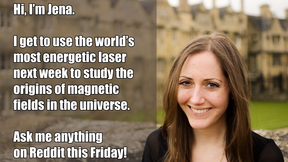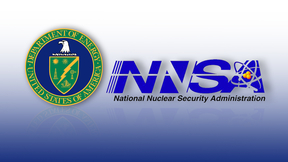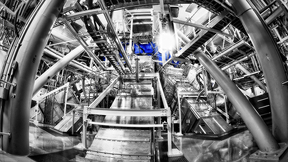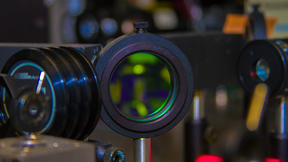Back
Hydrogen is the most abundant element found in the universe, making up nearly three-quarters of all matter. Despite its prevalence, questions about the element remain.In a new paper published today by Nature Communications, a team of researchers, including scientists from Lawrence Livermore National Laboratory (LLNL), aims to answer one of those questions – what happens to…
Christopher Barty, the chief technology officer for the National Ignition Facility and Photon Science Directorate, has won the 2016 SPIE Harold E. Edgerton Award for his work on ultrafast lasers and laser-based X-ray and gamma ray science."I feel very honored to have won this award and to now be somehow associated with the legacy of ‘Doc’ Edgerton," Barty said.Edgerton was…
In 1967, a hexagonal form of diamond, later named lonsdaleite, was identified for the first time inside fragments of the Canyon Diablo meteorite, the asteroid that created the Barringer Crater in Arizona.Since then, occurrences of lonsdaleite and nanometer-sized diamonds have been speculated to serve as a marker for meteorite impacts, having also been connected to the…
Lawrence Livermore National Laboratory (LLNL) physicist Tammy Ma has been selected for a 2016 Presidential Early Career Award for Science and Engineering (PECASE), one of 106 recipients nationwide and one of 13 from the Department of Energy. The awardees will be honored in a ceremony later this year.Ma was recognized for her "innovation and leadership in quantifying…
University of Oxford graduate student Jena Meinecke has literally prepared for years and traveled around the world for the chance to conduct experiments on the National Ignition Facility (NIF). Meinecke is one of about 600 members of the NIF user community — researchers who are interested in experiments on the world's most energetic laser. Her quest: probe the origins of…
Scientists from Los Alamos National Laboratory (LANL) are leading an experimental campaign on the National Ignition Facility (NIF) designed to further understand turbulent mix models used in both high energy density (HED) and inertial confinement fusion (ICF) experiments. NIF is the only facility with the energy and shot-to-shot reproducibility needed for the experiments…
Fast ignition (FI) is an alternative approach to conventional inertial confinement fusion that involves separating the compression and heating phases of the implosion, using a more stable compression followed by a short burst of localized heating. By separating these two aspects, the fuel can be compressed isochorically (without a central hotspot), reducing the fuel…
The High-Repetition-Rate Advanced Petawatt Laser System (HAPLS) under construction at LLNL recently achieved a key average power milestone more than two months ahead of schedule, and is now moving into the next phase in its development.The HAPLS high-energy diode-pumped solid-state pump laser, firing at a repetition rate of 3.3 Hz (3.3 shots per second), achieved 70 joules…
Lawrence Livermore National Laboratory researchers have created a library of nanoporous gold structures on a single chip that has direct applications for high-capacity lithium ion batteries as well as neural interfaces.Nanoporous gold (np-Au), a porous metal used in energy and biomedical research, is produced through an alloy corrosion process known as dealloying that…
Lawrence Livermore National Laboratory researchers are the recipients of three awards among the top 100 industrial inventions worldwide for 2014.The trade journal R&D Magazine announced the winners of its annual awards, sometimes called the "Oscars of invention," Friday in Las Vegas. With this year's results, the Laboratory has now captured a total of 155 R&D…
The proven success of the Stockpile Stewardship Program (SSP) – which pushed the limits of modern science and engineering by requiring the transition from explosive nuclear weapons testing to what is effectively virtual nuclear testing – was celebrated Wednesday at a half-day public event hosted by the Department of Energy’s National Nuclear Security Administration (NNSA)…
In a recent series of papers, Lawrence Livermore National Laboratory (LLNL) scientists examined the role of ablation-front instability and capsule convergence ratio in ignition science experiments at the National Ignition Facility (NIF).The papers address different aspects of an "adiabat-shaping" experimental campaign, which was performed to controllably assess the effects…
Rare earth elements are used in computer hard drives, electric motors and to generate and amplify the lasers at Lawrence Livermore’s National Ignition Facility (NIF). Future applications may include serving as memory for a quantum computer or the basis for ultrastable clocks. In recent work by LLNL scientist Michael Hohensee and colleagues, the team shows that the…
The Fusion Power Associates (FPA) Board of Directors has selected Lawrence Livermore National Laboratory (LLNL) nuclear engineer Susana Reyes as the recipient of its 2015 Excellence in Fusion Engineering Award. The FPA also will present a Special Award to LLNL fusion scientist Wayne Meier. The awards will be presented at the FPA’s 36th Annual Meeting and Symposium, …
A National Ignition Facility (NIF) experimental campaign may have unlocked scientific secrets behind how hydrogen becomes metallic at high pressure."Hydrogen properties are still puzzling," said Lawrence Livermore National Laboratory (LLNL) physicist Marius Millot. "In particular, back in 1935, it was predicted that hydrogen should become metallic at sufficiently high…
A multi-institutional team of scientists fired the 26th and final shot of the Pleiades experimental campaign at the National Ignition Facility last month. The campaign has created a new scientific foundation for the study of supersonic radiation flow in astrophysical phenomena and in inertial confinement fusion physics.Begun in 2011, the campaign was fielded by Los Alamos…
Last week, the National Ignition Facility (NIF) fired its 300th laser target shot in fiscal year (FY) 2015, meeting the year’s goal more than six weeks early. In comparison, the facility completed 191 target shots in FY 2014. Located at Lawrence Livermore National Laboratory (LLNL), the NIF is the world’s most energetic laser.Increasing the shot rate has been a top…
Laser wakefield acceleration, a process where electron acceleration is driven by high-powered lasers, is well-known for being able to produce high-energy beams of electrons in tabletop-scale distances. However, in recent experiments, a team of scientists from Lawrence Livermore National Laboratory (LLNL) and the University of California, Los Angeles (UCLA) revealed new,…
Physics of Plasmas (PoP), a peer-reviewed journal publishing original experimental and theoretical contributions in plasma physics, recently released a list of the most-cited papers for January-June 2015.Out of the 30 most-cited papers on the list, the top five had lead authors from Lawrence Livermore National Laboratory. No. 8, 9 and 17 on the list were also led by LLNL,…
Pierre Michel, a physicist at Lawrence Livermore National Laboratory (LLNL), has been awarded the 2015 Edouard Fabre Prize for his pioneering research into energy transfer between crossing laser beams in National Ignition Facility (NIF) hohlraums.Named for one of the founders of inertial confinement fusion (ICF) in Europe, the Edouard Fabre prize is awarded to active…
























